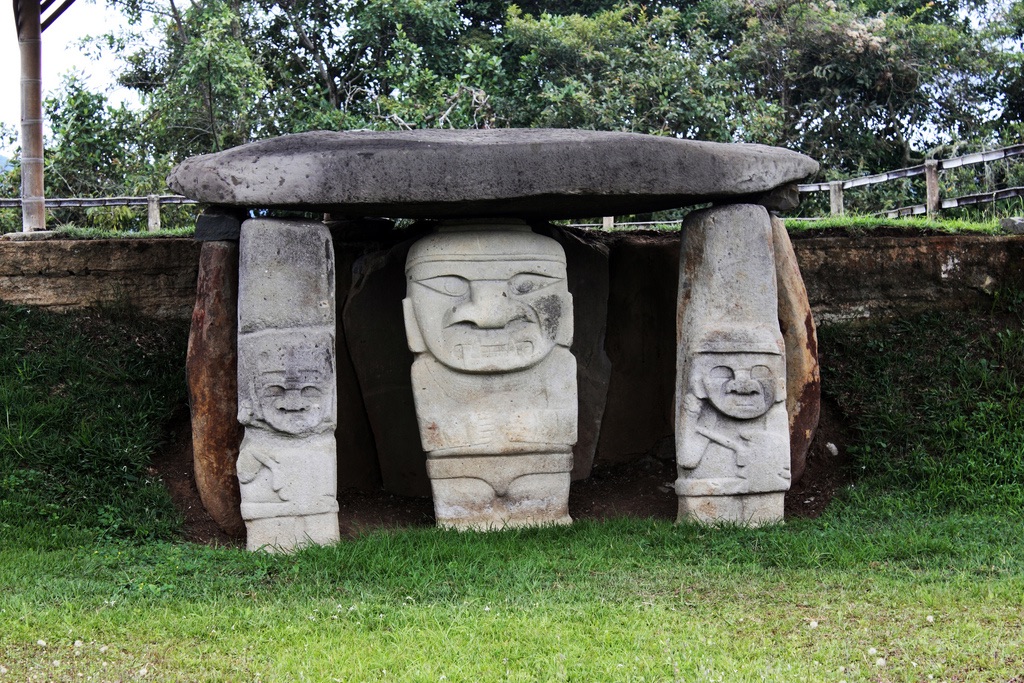Nestled in the Andean foothills of Colombia, the San Agustin Archaeological Park is a treasure trove of ancient mysteries. This UNESCO World Heritage site boasts the largest collection of religious monuments and megalithic sculptures in South America. These artifacts date back to the 1st to the 8th century AD, offering a glimpse into a pre-Columbian civilization that once thrived here. The park spans over 2,000 hectares and includes ceremonial centers, burial mounds, and over 500 monolithic statues, some towering over seven meters high. The intricate carvings and designs on these statues provide invaluable insights into the beliefs, rituals, and cosmology of the ancient San Agustín culture.
Get your dose of History via Email
Historical Background of San Agustin Archaeological Park
The San Agustin Archaeological Park, located in the Huila Department of Colombia, was discovered in the 20th century. However, the area remained largely unexplored until the Colombian government declared it an archaeological park in 1993. The park’s origins trace back to a mysterious civilization that inhabited the region long before the arrival of the Spanish conquistadors. This civilization, known as the San Agustín culture, left behind an impressive legacy of art and architecture.
The Agustinian people built the park’s structures and sculptures between the 1st and 8th centuries AD. They carved the statues from volcanic rock, depicting a variety of figures, including animals, mythical creatures, and human-like forms. These figures often feature elaborate headdresses, suggesting a complex social structure with religious and ceremonial significance.
After the decline of the San Agustín culture, the area saw various groups come and go. The park was not the scene of any known historically significant events following the Agustinian era. However, its rediscovery and subsequent archaeological studies have shed light on the region’s pre-Columbian history.
The park’s discovery is attributed to local treasure hunters and explorers in the 18th and 19th centuries. Konrad Theodor Preuss, a German ethnologist and archaeologist, conducted the first scientific study of the site in the early 20th century. His work laid the foundation for future archaeological research in the area.
Despite its discovery and some exploration, much of the park remains unexcavated. This leaves a vast potential for future discoveries that could further unravel the mysteries of the San Agustín culture and its people.
About San Agustin Archaeological Park
San Agustin Archaeological Park is a complex of ruins, sculptures, and tombs. The park’s main attractions are the monumental statues, some of which stand over seven meters tall. These statues are scattered throughout the park, often aligned with burial sites and ceremonial centers.
The methods of construction and building materials used by the San Agustín culture were primarily local volcanic rock. They carved the statues using simple stone tools, which is a testament to their skill and craftsmanship. The park also features a variety of terraces, canals, and mounds, suggesting advanced knowledge of engineering and agriculture.
Architectural highlights include the Fuente de Lavapatas, a complex labyrinth of channels and pools carved into the bedrock, believed to have been used for religious ceremonies. The park also contains several burial mounds, known as mesitas, which provide insights into the funerary practices of the Agustinian people.
The park’s layout and the positioning of the statues indicate a sophisticated understanding of spatial organization and symbolic representation. The carvings on the statues depict a range of imagery, from serene faces to fierce warriors, animals, and abstract symbols, all of which hold various interpretations.
The park’s preservation efforts include the Museo Arqueológico, which houses a collection of artifacts and provides context for the outdoor exhibits. The museum helps visitors understand the significance of the park’s cultural heritage and the importance of its conservation.
Theories and Interpretations
Several theories exist about the use and significance of the San Agustin Archaeological Park. The most widely accepted theory is that the area served as a religious and ceremonial center for the San Agustín culture. The statues are believed to represent gods, ancestors, or mythical beings, playing a role in ritual practices.
The mystery of the park is deepened by the lack of written records from the San Agustín culture. This has led to various interpretations of the carvings and symbols found on the statues. Some researchers suggest that the imagery represents a cosmology that includes shamanism and animal worship.
Dating of the site has been carried out using methods such as radiocarbon dating and stratigraphy. These techniques have helped establish the timeline of the San Agustín culture and the construction of the park’s structures. However, the exact reasons for the culture’s decline and the abandonment of the site remain unknown.
The park’s statues and their possible astronomical alignments have also been a subject of study. Some researchers propose that the Agustinian people had advanced knowledge of astronomy, which they incorporated into the design of the park.
Despite ongoing research, the San Agustin Archaeological Park continues to hold many secrets. The interpretations of the site are constantly evolving as new discoveries are made and existing findings are reevaluated.
At a glance
Country: Colombia
Civilization: San Agustín culture
Age: 1st to 8th century AD
Conclusion and Sources
Reputable sources used in creating this article include:
– UNESCO World Heritage Centre: https://whc.unesco.org/en/list/744

